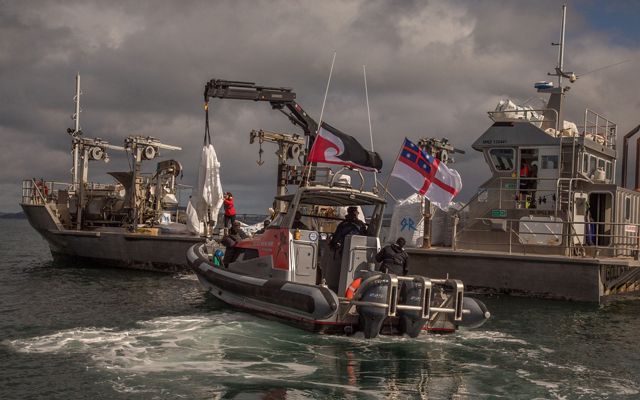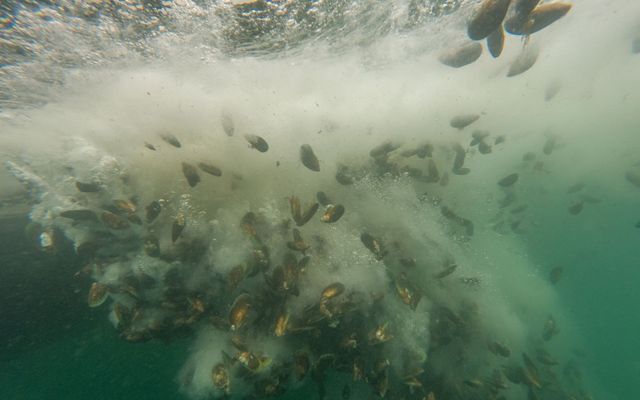Seven million kūtai (green-lipped mussels) have been deployed into the Hauraki Gulf/Te Moananui-ā-Toi/Tīkapa Moana in a bid to reverse the decades-long impacts of destructive fishing practices, invasive species, climate change and acidifying waters.
In July 2024, Ngāti Manuhiri Settlement Trust, as a partner of the Revive Our Gulf project, placed millions of kūtai in Kawau Bay to the north of Auckland, close to the beautiful Tāwharanui Peninsula.
The Revive Our Gulf project is a collaboration between The Nature Conservancy Aotearoa New Zealand, The University of Auckland and the Mussel Reef Restoration Trust and is supported by the Challenge Fund with Foundation North matching donations dollar for dollar.
Quote: Katina Conomos
Healthy shellfish in the Hauraki Gulf are key to healthy marine ecosystems. We need to bring them back.
“Kūtai are absolutely crucial to maintaining the health of our wai/water, but our once abundant kūtai populations have been severely depleted by human activity and climate change,” says Ngāti Manuhiri Settlement Trust Chief Executive Nicola MacDonald.
“By reestablishing these kūtai reefs, we are taking solid and decisive action to reverse the human impacts on the Gulf and give our wai a fighting chance to ensure it is stable enough to support us now and into the future.”
Kūtai are ecosystem engineers, providing food, shelter and protection for diverse species as well as filtering impurities from the seawater.
“In the 1950s and 1960s, the extensive kūtai reefs of Te Moananui-ā-Toi were commercially dredged to the point of collapse. Despite the advent of mussel farming, wild mussels never returned in large numbers,” says Revive Our Gulf Programme Director Katina Conomos.
"Healthy shellfish in the Hauraki Gulf are key to healthy marine ecosystems. We need to bring them back."


“We are developing knowledge for how to restore kūtai populations in Te Moananui-ā-Toi at scale. Ngāti Manuhiri Settlement Trust is a very committed partner to this kaupapa/principle, and their bold leadership is essential to this mission.”
“Originally the spat, or baby kūtai, are collected from Te Oneroa-a-Tōhe (Ninety Mile Beach), then grown to size on a mussel farm in Coromandel and then brought here by barge.”
“These kūtai have come a long way to help us restore this part of Aotearoa, and we’re grateful to them and those that have nurtured them to this point.”
This deployment is the second conducted in partnership with the Ngāti Manuhiri Settlement Trust and is part of a wider project to develop knowledge around the restoration of the kūtai reefs throughout Te Moananui-ā-Toi/Hauraki Gulf.
Quote: Abbie Reynolds

The way that this project works hand in hand with mana whenua is particularly exciting, upholding the mana of all involved, and we are honoured to be a part of this important restoration work with the wider benefits that it entails.
“One of the other problems we are facing across the Gulf is the spread of the invasive seaweed exotic Caulerpa,” says Ms. MacDonald.
“Some of the techniques used to remove exotic Caulerpa involve chlorine and benthic liners to smother it; however, this can have a brutal scorching effect on the seabed and upset the conditions needed for our native plants and fish stocks to thrive.”
“Kūtai can help to filter the wai and restore it to ideal conditions for our marine life to flourish, particularly kōura (crayfish) and tāmure (snapper),” says Ms. MacDonald.

The Nature Conservancy Country Director for Aotearoa Abbie Reynolds says the kūtai restoration project is an internationally recognised example of successful Indigenous partnership.
“The way that this project works hand in hand with mana whenua is particularly exciting, upholding the mana of all involved, and we are honoured to be a part of this important restoration work with the wider benefits that it entails.”
The University of Auckland Institute of Marine Science Lecturer Dr. Jen Hillman, who is the science lead for Revive Our Gulf, describes this as cutting-edge marine research.
“We are learning as we go, and it’s a huge ongoing effort. This scale of work that Ngāti Manuhiri are driving is a world first in restoring these types of shellfish,” says Dr. Hillman.
TNC says:
We’re over halfway to reaching our Challenge Fund target of $2 million, which Foundation North is matching dollar for dollar. To find out more about how you can help us reach our target by March 2025, please contact Emma Dent—emma.dent@tnc.org.
More About the Deployment
- RNZ: Seven million mussels to be placed in Hauraki Gulf
- NZ Herald: Mussel power: Seven million kūtai deployed to help restore Hauraki Gulf ecosystem
- NZ Herald: 7 million mussel spat from Ninety Mile Beach on Hauraki Gulf marine rescue mission
- University of Auckland: Seven million mussels deployed to the Gulf as 'ecosystem engineers'
- Waatea News: Kūtai drop for Hauraki clean up
- TVNZ Seven Sharp: Seven million green lipped mussels to the rescue in the Hauraki Gulf
- bFM: Dropping Seven Million Kūtai into the Hauraki Gulf
The Nature Conservancy is a global conservation organization dedicated to conserving the lands and waters on which all life depends. Guided by science, we create innovative, on-the-ground solutions to our world’s toughest challenges so that nature and people can thrive together. We are tackling climate change, conserving lands, waters and oceans at an unprecedented scale, providing food and water sustainably and helping make cities more sustainable. The Nature Conservancy is working to make a lasting difference around the world in 81 countries and territories (40 by direct conservation impact and 41 through partners) through a collaborative approach that engages local communities, governments, the private sector, and other partners. To learn more, visit nature.org or follow @nature_press on X.
